Topic 1 - Cells SL revision list
This pages gives outline details of the content of the topic together with essential questions and student skills and applications. Helpful for revision.
1.1 Introduction to cells
Cell theory
- According to cell theory, living organisms are composed of cells.
- Organisms consisting of only one cell carry out all functions of life in that cell. e.g. Paramecium, Chlorella.
- Identifying the characteristics of living things (Mr H. Gren - metabolism, response, , homeostasis, growth, reproduction, excretion & nutrition)
- Surface area to volume ratio is important in the limitation of cell size.
- Multicellular organisms have properties that emerge from the interaction of their cellular components. (Emergent properties)
- Specialized tissues can develop by cell differentiation in multicellular organisms.
- Differentiation involves the expression of some genes and not others in a cell.
- Stem cells can divide and differentiate along different pathways in embryonic development which makes stem cells useful for therapeutic uses (e.g. Stargart's disease).
- There are ethical concerns about the use of embryo stem cells.
Revision Questions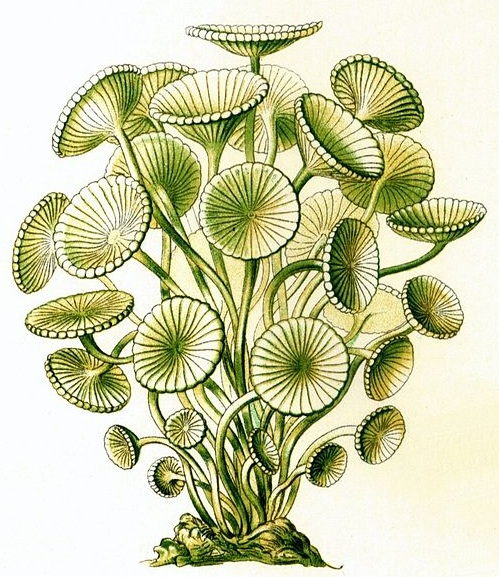
- Are all living things made of cells, even striated muscle or Acetabularia algae?
- Do cells all share the same structure?
- How does 'differentiation' lead to differences in structure?
- What are the seven processes of life which happen in cells?
- What sort of new properties appear when many cells live collaboratively in multicellular organisms?
- What are the special properties of stem cells?
- How can we use this knowledge of cells, to exploit stem cells for medical treatments?
Calculating magnification and size
- Calculate the magnification of an electron microscope image from a scale bar?
- Calculate specimen size using a scale bar?
- Calculate specimen size using magnification?
Revision Questions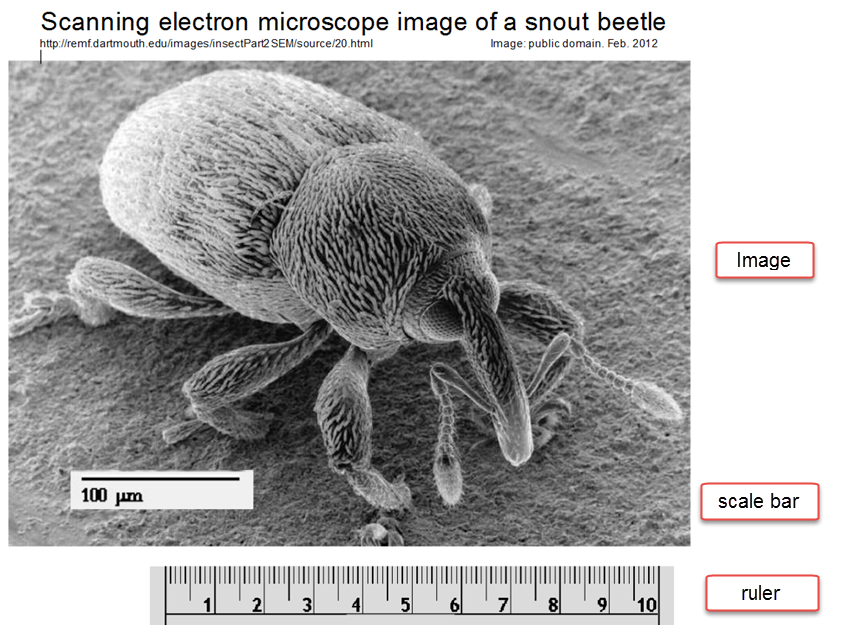
- What are three step to calculating magnification of an image?
- How can you estimate the size using the scale bar and your thumb?
- Calculate the size of this snout beetle by putting the following steps in the correct order:
- Convert the length in mm into the same units as the scalebar
- Divide the length of the scale bar on the image by 100µm
- Use a ruler to measure the length of the scale bar in mm
1.2 Ultrastructure of cells
- Know and be able to draw the simple structure of Prokaryote cells
- Know and draw the compartmentalised structure of Eukaryotic cells.
- Understand that the resolving power of electron microscopes is between 10µm and 1nm
- whereas light microscopes resolve details between 1mm and 1µm.
Revision Question(s) 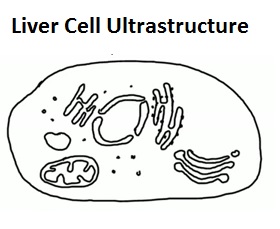
- How does the presence of membrane bound organelles benefit eukaryotic cells?
- How many different organelles are there?
- Do prokaryotes and eukaryotes share any common organelles?
- What do we mean by resolution, or resolving power of microscopes?
- Skill: Drawing prokaryotic cells (cell wall, plasma membrane, cytoplasm, pili, flagella, 70s ribosomes and nucleoid.) and eukaryotic cells (free 80s ribosomes, rough endoplasmic reticulum (rER), lysosome, Golgi apparatus, mitochondrion and nucleus) based on electron micrographs.
Student skills and applications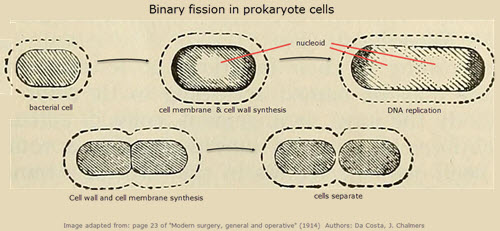
- Ability to identify organelles from microscope images of cells.
- Ability to explain how the composition of organelles will be different in cells with different functions,
(eg. goblet cells which make mucus and palisade mesophyll cells which do photosynthesis). - Explain how the structure of prokaryotes allows them to divide by binary fission.
1.3 Membrane structure & 1.4 function
Membrane structure
- Phospholipids form bilayers in water due to the amphipathic properties of phospholipid molecules.
- Membrane proteins are diverse in terms of structure, position in the membrane and function.
- Cholesterol is a component of animal cell membranes.
- Application: Cholesterol in mammalian membranes reduces membrane fluidity and permeability to some solutes.
- Can you draw a diagram of the fluid mosaic model.
- Can you explain how evidence from electron microscopy led to the proposal of the Davson-Danielli model.
- Can you outline the evidence which led to the falsification of the Davson-Danielli model and support of the Singer-Nicolson model.
Revision Question(s) 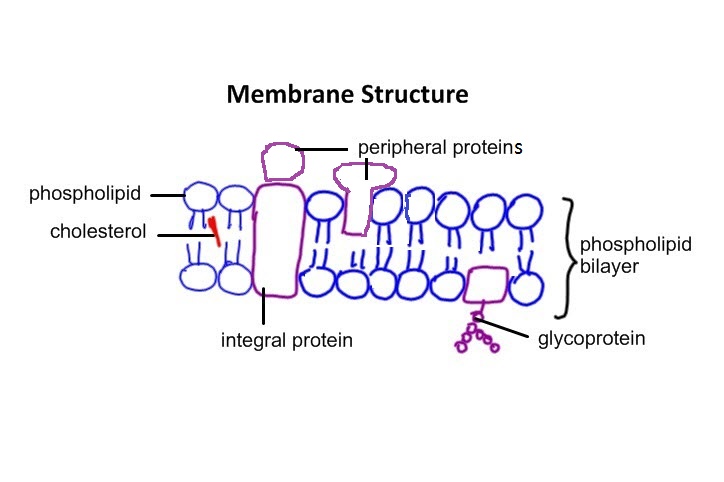
- Why do the lipid tails of phospholipids attract each other?
- How does a phospholipid bilayer prevent the loss of water from cells ?
- How can proteins attach to the bilayer?
- What functions can membrane proteins have within cells?
- What other substances are found in the plasma membrane in addition to protein and phospholipid?
Membrane transport
- Particles move across membranes by simple diffusion, facilitated diffusion, osmosis and active transport.
- The fluidity of membranes allows materials to be taken into cells by endocytosis or released by exocytosis. Vesicles move materials within cells.
- Know how the structure helps the function of sodium–potassium pumps for active transport and potassium channels for facilitated diffusion in axons.
- Understand why tissues (or organs) waiting to be used in medical procedures must be bathed in a solution with the same osmolarity as the cytoplasm to prevent osmosis.
- Skill: Estimation of osmolarity in tissues by bathing samples in hypotonic and hypertonic solutions. (Practical 2)
Revision Question(s) 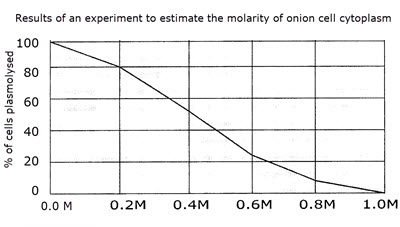
- How can cells control the movement of substances through the plasma membrane using the membrane proteins?
- How can the cell take in substances, like food particles, using membrane fluidity?
- What is the difference between hypotonic and hypertonic solutions?
- When a sample of cells is 50% plasmolysed we say that the solution they are bathed in has the same salt concentration as their cytoplasm. Estimate the concentration of the cytoplasm of the onion cells using the graph (on the right)?
Skills & Applications
- Application: Cholesterol in mammalian membranes reduces membrane fluidity and permeability to some solutes.
- Skill: Drawing of the fluid mosaic model.
- Skill: Analysis of evidence from electron microscopy that led to the proposal of the Davson-Danielli model.
- Skill: Analysis of the falsification of the Davson-Danielli model that led to the Singer-Nicolson model.
- Application: Structure and function of sodium–potassium pumps for active transport and potassium channels for facilitated diffusion in axons.
- Application: Tissues or organs to be used in medical procedures must be bathed in a solution with the same osmolarity as the cytoplasm to prevent osmosis.
- Skill: Estimation of osmolarity in tissues by bathing samples in hypotonic and hypertonic solutions. (Practical 2)
1.5 The origin of cells and 1.6 cell division
- The first cells must have arisen from non-living material.
- The origin of eukaryotic cells can be explained by the endosymbiotic theory.
- Mitosis is division of the nucleus into two genetically identical daughter nuclei.
- Chromosomes condense by supercoiling during mitosis.
- Cytokinesis occurs after mitosis and is different in plant and animal cells.
- Interphase is a very active phase of the cell cycle with many processes occurring in the nucleus and cytoplasm.(including G1, S, G2)
- Cyclins are involved in the control of the cell cycle.
- Mutagens, oncogenes and metastasis are involved in the development of primary and secondary tumours.
Revision Question(s)
- What is the role of cell division in the origin of life?
- Where did the first cells come from
- As well as dividing can cells join together?
- What would happen if one cell engulfed another without killing it?
- What are the stages in cell division by mitosis?
- How do cells control the cell cycle?
- What causes cell division to go wrong and become cancer?
Skills
- Application: Evidence from Pasteur’s experiments that spontaneous generation of cells and organisms does not now occur on Earth.
- Application: The correlation between smoking and incidence of cancers.
- Skill: Identification of phases of mitosis in cells viewed with a microscope or in a micrograph.(prophase, metaphase, anaphase and telophase).
- Skill: Determination of a mitotic index from a micrograph.
